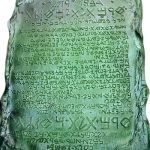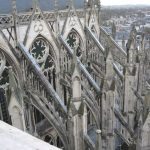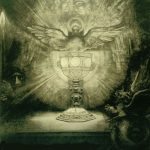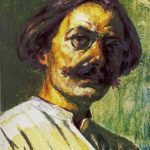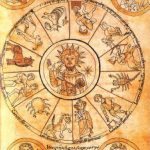Chapter Nine
To understand Islam, we must look away from the urban centers of the late classical world. After the destruction of the Temple in 70 CE, Jerusalem was a Roman city in a Roman/Greek world. Constantinople, the jewel of the eastern Empire, was the center of Christian civilization, while Rome had been sacked and Vandalized to the point where nothing much remained except depopulated ruins, the Church and the echoes of its ancient glories. The west still struggled to recover from the collapse of the Empire, a political disaster which left the Imperial Church in charge of what was left. Even the spiritual currents which had held such promise in the first century CE, Gnosticism, Christianity, mystical Judaism and so on, had been destroyed, marginalized or co-opted by its avowed enemy, the Roman State.
But out in the wilderness, in the depths of that vast desert known as the Arabian peninsula, something very old was stirring. It would have a new, improved form, one that acknowledged the Judeo-Christian world view. Stamped with the imprint of its founder, his hometown and the culture of his family, Islam would become something very different from anything that had gone before.
One of those differences is that, of all the major world religions, Islam is most clearly and profoundly the work of one man, Mohammed ibn Abdallah, grandson of the Great Abd al’Muttalib, Sharif of the Beni Quraish, protector of the Shrine of The God and the altars of His eight wives, the Kaaba of Meccah. Therefore, it is to Meccah that we must look to understand Islam.
Forty miles or so inland from Jiddah, its ancient port, Meccah sits at the juncture of pre-Islamic Arabia’s most important trade routes. The mile-long caravans from the spice kingdoms of southern Arabia, on their way to the world markets of Mesopotamia, turned north and east through the gap in the Hejaz Mountains near Meccah. Cargo from Africa — Abyssinia lies just across the Red Sea — landed at Jiddah and moved inland for its first stop-over at Meccah. The town thrived on trade and travelers. This is significant, because from its founding Meccah was also an important sacred site and a destination for pilgrims.
The ancient Arabs were pantheist who worshipped the spirit, or genius, of place in a large variety of ways, including pilgrimage and animal — and sometimes human — sacrifice. They personified the sun and the moon, the sky, stars and the desert and lived in a world filled with jinns and afreets, or spirits and ghosts. In the vast darkness of the desert, the stars became the backdrop against which the mythological drama of life played itself out. Navigating in the desert, as at sea, required a knowledge of the stars and their relationship to time and movement. These factors gave rise to a complex astrological mythology, similar, if not exactly the same, to that found in the oldest sections of the Sepher Yetzirah, the work of creation, which are attributed to Abraham.
Abraham, as we discovered in the Talmud, was the most famous astrologer of his time. We are told that the kings of the East and the West, attributed to Egypt and India by modern scholars, waited at his door for his council. Interestingly enough, even in the 18th century BCE, Meccah was a junction point in the trade between India and Egypt. According to the tradition within the Quraish, Mohammed’s clan, Meccah was also founded by Abraham and his other son Ishmael, who name means God hears, from the same proto-semitic root as Islam.
From the Sepher Yetzirah, we learn of the Cube of Space (the twelve edges of the Cube are formed from the twelve double letters of the Hebrew alphabet which are attributed to the signs of the zodiac) within which the jewel-like Tree of Life forms. This astrological concept is attributed to Abraham just as the building of the physical Cube, the Kaaba of Meccah with its sacred Black Stone, is also claimed as his work. According to Moslem tradition, the Kaaba, or cube (from the same root), has been rebuilt ten times, completing the number of spheres on the Tree of Life. The Kether, or crown, Cube was built by the angels in heaven, we are told. It this Cube that is described in the Sepher Yetzirah and The Bahir.
Wisdom and Understanding, the second and third Cubes, were built by Adam and his youngest son Seth. The fourth, Mercy, an after-the-Flood restoration, was built by Abraham and his son by Hagar, Ishmael. It is from this point that Meccah dates its founding. Strength and Beauty, the fifth and sixth, are attributed to kings of the Sabean and Himyarite Kingdoms. The seventh, Victory, was built by Quasy, the patriarch of the Quraish. The eighth, Splendor, was done during Mohammed’s lifetime and the ninth and tenth, Foundation and Kingdom, within sixty years of his death.
Within the Cube is the sacred Black Stone, a piece of purplish-red tektite, the stone which fell from heaven. Embedded in the wall of the southeastern corner about five feet from the floor — at just the right height for kissing — The Black Stone has been a part of the Cube since at least the version attributed to Abraham. Tradition states that the Stone represents the new, post-catastrophe covenant between God and the family of Abraham.
Moslem scholars also point to a verse in Matthew, chapter 21:42-43, for support. Jesus, during his last week in Jerusalem, often came to the forecourt of Herod’s Temple to teach. Matthew tells us that as Jesus entered the Temple that morning, he was accosted by the chief priests and the elders who demanded by what authority he taught the scriptures. Jesus asks them a question: Was John baptized by heaven or by men? When the elders can’t answer, Jesus refuses to tell them his authority and then lays into them for spiritual blindness. Even the people on the street, the obvious sinners, could see that John was a man of righteousness, Jesus tells them, but you, the spiritual leaders of the people, still can’t decide on the source of John’s message.
He continues, making the point even sharper, with the parable of the tenants who wouldn’t share the fruits of the harvest with the landlord of the vineyard, but instead killed his servants and his son. Jesus asked the elders what did they think would happen when the owner returned? They replied that he would turn the tenants out of the vineyard, of course. Jesus then drove the point home by quoting Psalms 118: 22-23: “The stone the builders rejected has become the head of the corner; the Lord has done this, and it is marvelous in our eyes.” To make sure they got it, Jesus said: “Therefore I tell you that the Kingdom of Heaven will be taken from you and given to those who will produce the fruit.” This encounter was likely the motivating incident that led to Jesus’ betrayal and death. From this point on, we are told by the Gospels, the Jewish elders plotted a way to arrest him without the people, who held him as a prophet according Matthew 21:46, knowing and interfering.
Christian commentators see this as the shift from Judaism to Christianity, with Christ as the Stone the builders rejected. Jesus is clearly stating that the Jewish elders no longer understood the basis of the religion they professed. To the Moslems however, who had seen how little spiritual fruit Orthodox Christianity produced, this verse suggested another interpretation. The rejected stone is Ishmael, the part of Abraham’s progeny rejected by Israel, as well as a rejected, cast out of the sky, part of heaven. Israel broke its Abrahamic covenant, therefore the kingdom of heaven reverted to the other heir, Ishmael, who will gather the fruits of the harvest.
The landlord of the vineyard of course is Allah to the Moslem, not the more Hebraic Jaweh. In Genesis 14:18, we are told that after a great battle, Abram, as he was then, worshipped the God Most High with the King of Jerusalem, Melchizedek. As we have seen in the Bahir, this was thought to be Shem, a son of Noah and a survivor of the Flood, and Abraham’s teacher and collaborator in the work of creation. The titles used in the verse, “God Most High, Lord of Heaven and creator of the earth,” are the same titles used for Baal, the ancient Caananite name for the Pole Serpent, the Teli, which the Sepher Yetzirah tells us is over the “universe. . .like a king on his throne.”
Allah is simply the Arabic version of this Caanaite El. Baal, or rather Ba-el, is literally translated as the Space-Filling God, and is further called “He who holds the stars in place.” This God Most High can only be the constellation of Draco, who fills all the signs of the zodiac and sits atop the Cube of Space very much like a king on his throne. In the pre-Islamic Kaaba, the house of Allah contained altars to his eight wives and daughters. These ancient goddesses are clearly related to the seven planets and the earth. Al-Uzza, the mighty one, was the sun and Al-Manat, the triple faced goddess, was clearly the moon. The earth goddess, Al-Lat, the goddess, is actually talah, or Teli, spelled backward. This serves to clinch our identification of Allah with the Teli, or Pole Serpent.
From the ground looking up at Draco, the ancient astronomers saw that it curved around the still point of the ecliptic pole and then its tail bent backward to form the “L” shape from which the word El was derived. Reflected on the earth however, as in the case of the earth goddess, this “L” of the Teli or Pole Serpent is reversed. If Allah is the God Most High, the “L” in the sky, then his daughter the earth is the reflection of that nature.
The Quraish, who thought of themselves as descendants of Abraham, worshipped Allah as their chief god, the Lord of the Soil to Whom they must pay a tithe of their crops and herds. This was not quite monotheism — Allah still had his wives — but it paved the way for Mohammed’s insistence that Allah was the One and only God. Mohammed. like Abraham, decided that the God Most High was the only god worthy of worship.
Genesis tells us that, soon after Abram received the blessing of the God Most High, The Lord visited his word upon him in a vision. He commanded Abram to look up at the stars and count them if he could. Abram’s descendants will be as numerous as the stars, or possibly will be as the stars, if Abram will make a covenant with the Lord by performing a peculiar ritual sacrifice. Abram is told to take five animals, split the heifer, the goat and the ram in two halves, and leave the two birds whole. The ten resulting halves can be attributed to the spheres on the Tree of Life, according to the sages of the Sepher Yetzirah.
This arrangement polarized the Tree, normally seen aligned along three parallel axis, into two groups of five, like the fingers on each hand. The spheres were then attributed by their masculine or feminine qualities. Six are clearly polarized, since they occur on the right or left pillar of the Tree, while the other four are normally on the middle axis. Attributing them this way produces a shift or split between Tiphareth and Binah on the left hand and between Yesod and Tiphareth on the right. This is the origin of the Rabbanical blessing gesture — the gap between the third and fourth fingers made famous by Star Trek’s Vulcans — and symbolizes Abram’s arrangement of offerings.
Abram made his sacrifice at sunset and fell into a deep sleep. We are told that thick and dreadful darkness came over him and the Lord spoke within it describing the future of Abram’s descendants. And then a curious thing happened. A smoking firepot with a blazing torch, an ancient symbol of the presence of the God Most High according to most authorities, passed between the pieces of the sacrifice, through the gap between Binah and Tiphareth and Yesod and Tiphareth. This, Genesis tells us, sealed the covenant between Abram and his god.
When Abram was 99 years old, The God Most High made a return appearance to confirm the covenant. This time the Lord changed Abram’s name to Abraham, by adding an h, or heh, in the middle, and instituted the rite of circumcision as a physical sign of man’s acceptance of the covenant. From this point on, Abraham’s descendants were the chosen people of the God Most High.
Much of this makes little sense, until we remember that, in the Bahir, the twelve edges of the Cube of Space are also the zodiacal paths connecting the spheres on the Tree. The gap or aisle between the sacrifices, like the gap between the rabbi’s fingers in the blessing, represents the astrological signs of Sagittarius and Gemini. These signs mark the third dragon-axis, as we noted above, which is the axis of the galaxy itself. The firepot with a blazing torch, symbol of the presence of the God Most High, travels the major axis of the galaxy, from the center out to the edge.
Abraham made his covenant then with the creative force flowing outward from the galactic core. He called this the God Most High, Mohammed’s Allah, who formed our world from the intersection of the three pillars or axis of the Teli. Abraham’s descendants entered the galgal, or cycle of time, through the Heh, or window, added to his name by the Lord. Heh is attributed to Aquarius, a zodiacal sign at right angles to the axis of the galaxy, and symbolizes the moving axis of the Coiled Serpent which defines the evolutionary flow of human events. Abraham’s descendants would be the chosen of God as long they remembered the window into the cycle of Time which God had given them.
The Black Stone was the physical seal of this covenant, a token of God’s favor. It is interesting to note that the description in Genesis 15:17, our smoking firepot with a blazing torch coming out of it, suggests the path of a meteor through the atmosphere. The place of the Black Stone within the Kaaba also suggests the northwest-southeast axis of the galaxy as seen in two dimensions. The stone which fell from heaven is a physical piece of evidence for the presence of the God Most High. With this in mind, we can understand the reference in Psalms to the rejected stone which became the head of the corner, and Jesus’ denunciation of the Jewish elders for not understanding their own religion. It also helps to explain the nature of Mohammed’s revelation.
If Jesus, like Rabbi Jehoshua, was a student of the Bahir then he would have known the secret of the Teli. From the elders’ answer to the question of authority, Jesus knew that they no longer grasped the secret of time. John the Baptist had preached that the kingdom of heaven was near, how could he have known that? This is really what Jesus is asking the priests and elders. They of course had no answer, so Jesus refused to tell them the truth.
Mohammed, like Abraham, received his wisdom directly from an angelic messenger. The Qur’an, the collection of Mohammed’s revelations written down within fifty years of death by followers who had memorized them as they were pronounced, leaves little doubt of that fact. Like all successful prophets and spiritual leaders, Mohammed gave voice to the needs and longings of his time.
Many Arabs had been influenced by the Christians and the Jews who lived among them and eagerly awaited their own messenger from God. Mohammed admired the morals of Christianity and the monotheism of the Jews. He was also conscious of the power of a divinely inspired scripture to mold a religion. Others may have had similar thoughts. From Byzantine sources, we hear of several Arabs “prophets” who rose to prominence during the late sixth and early seventh centuries. Mohammed’s difference, and perhaps the root of his success, lies in his connection through the Kaaba with the mysteries of creation given to Abraham. He could speak with authority because he had rediscovered the window into the cycles of time.
The revelations began on the night of the 27th of Ramadan in the year 610 CE. Mohammed was alone in the great cave at the foot of Mt. Hira, a few miles outside of Meccah. He had gone to the cave to pray and meditate, but he was asleep when the angel Gabriel appeared and demanded that he read. Since Mohammed was illiterate, he protested that he could not read. Then the angel pressed down on him to the point that he thought he was going to smother to death. When the angel released him, Mohammed sat up and read. On awakening, Mohammed felt that words were engraved on his heart. He fled out of the cave, into the early morning sunlight, and beheld a vision of the angel Gabriel as the cosmic man. Gabriel declared that Mohammed was indeed the messenger of Allah.
Thereafter, the revelations came thick and fast. Often, when they came, Mohammed would fall to the ground in a convulsion or a swoon. He would become drenched with sweat and even his camel would become nervous and skittish when a spell hit. He was transformed by these experiences from the shy and introspective orphan who married a wealthy older woman, ran her businesses and never spoke in the Quraish councils.
His cousin and son-in-law, Ali, has left us a vivid description of Mohammed a few years after his revelations began. He describes Mohammed as “of middle stature, nether tall nor short. His complexion was rosy white; his eyes black; his hair, thick, brilliant and beautiful, fell to his shoulders. His profuse beard fell to his breast. . .There was such sweetness in his visage that no one, once in his presence, could leave him. If I hungered, a single look at the Prophet’s face dispelled the hunger. Before him, all forgot their griefs and pains.”
Later, when pressed to describe the process of revelation, Mohammed declared that the entire text of the Qur’an was written in heaven, and that Gabriel communicated it to him one piece at a time. Asked how he could remember these divine discourses, Mohammed replied that he repeated each phrase after the angel. The stress, he said, caused his hair to turn gray.
For a decade, Mohammed preached in Meccah, making little headway except for his immediate family and the Companions, such as Abu Beker and Omar al-Khattab. For a while he moved to al-Taif, a center of the goddess Al-Uzza, the mighty one worshipped by his mother’s clan. From this brief exodus came the so-called “Satanic Verses” where the Qur’an seems to endorse goddess worship. Within the year, Mohammed was back in Meccah preaching in front of the Kaaba.
This time however, he was without protection. The control of the clan had passed to the mortal enemies of Mohammed’s uncle, and the new faith found itself severely persecuted. But, just when things looked bleakest, a miracle happened, or so it seemed to Mohammed. Before he left for al-Taif, Mohammed had preached to a group of pilgrims from the garden city of Yathrab, which would afterward be forever Medina, or The City. They accepted his teaching and began to spread the word back home. Yathrab had a large Jewish population who responded to Mohammed’s teachings as similar to their own. They were willing, in the garden city of Yathrab, to accept Mohammed as the messenger of a monotheistic Allah who will reign over the earth at the Last Judgment.
Eight years later, after much skirmishing and caravan raiding, Mohammed marched back into Meccah as the conquering messenger. He cleaned out the Kaaba, removing the altars to Allah’s wives and daughters but keeping the Black Stone and its ritual kiss, and then proclaimed Meccah the Holy City of Islam. For the last two years of his life, Mohammed ruled from Meccah with a leisurely hand. As the faith grew, Mohammed sent letters to the capitals of the world announcing his revelation. He received no replies and watched philosophically the mutual destruction of Byzantium and Persia. There is no indication that Mohammed ever considered spreading the faith outside of Arabia.
That was not the case however with his heirs. Mohammed had appointed no successor to his power. After a brief rivalry, the Moslem leaders elected Abu Beker, the first Companion, to be Khalifa, or representative of the faithful. Abu Beker’s faith and steadfastness saw the Faith through its first war and rebellion. Khalid ibn al-Walid, the most brilliant and ruthless of the Arab generals, went on from pacifying Arabia to defeat the Greek Emperor Heraclius outside Damascus. Syria became an Arab and Islamic stronghold.
By then Abu Beker had died and his fellow Companion, Omar al-Khattab, had been elected Caliph. Omar encouraged the conquest, and by 644, when Omar was cut down by a Persian slave in the Medina mosque, Moslem armies ruled Egypt, Palestine and Persia. The conquests continued under Othman the Unfortunate, until by the time of Ali’s Caliphate, 656-661, the Islamic domains extended from the Atlas Mountains in North Africa to the Black Sea and the mountains of Afghanistan.
Less than thirty years after the death of the Prophet, Islam ruled more of the earth than Rome had at its height. It is even to this day hard to imagine how a political, social and religious shift of this magnitude could have happened. The Prophet would merely have shrugged and replied Inshallah, that is, God is willing.
There is of course more to it than that. Mohammed taught of a stern yet merciful God in terms more than faintly reminiscent of the Bahir and the Sepher Yetzirah. In the Qur’an, sura II:255, the famous Throne Verse, we find Allah described in terms remarkably similar to those used to describe the Teli, or Pole Serpent. “His Throne extends over the heavens and the earth. . . He alone is Most High and Supreme.”
The Qur’an is filled with references to the Last Judgment. Only Allah, the Qur’an tells us, knows the time of the Last Judgment, but certain signs will prefigure its arrival. Unbelief will be widespread along with moral chaos. There will be tumults in the sky and on the earth, sedition and great wars will occur, of such magnitude that the wise men will wish themselves dead. The final signal will be three trumpet blasts. At the first, our material universe will be destroyed. The second will uncreate all men and angels and spirits, while the third will accomplish the resurrection. Then Allah will arrive to conduct the Judgment. Only those who can cross the bridge of al-Sirat, which is finer than a hair and sharper than a sword, will be allowed to enter Paradise.
In the Qur’an, Paradise is described in ways that would make a gnostic Chilaist drool with envy. Paradise is a perfect garden where all manner of good things to eat and drink are available, including wine that exhilarates while leaving one clear-headed. These eternal feasts are attended by nubile houris whom neither age nor weariness nor death can mar. The blessed will see the face of Allah and become immortal, “never growing old.” Who could resist such an image of Paradise?
The most significant sura, or chapter, in the Qur’an, from the perspective of the secret at the heart of alchemy, is sura 24, Al-Nur, or The Light. In verse 35, the secret is revealed with blinding clarity. “Allah is the light of the heavens and the earth. The semblance of His light is that of a niche in which is a lamp, the flame within a glass, the glass a glittering star as it were, lit with the oil of the blessed Tree, nether of the East nor of the West, whose oil appears to light up even though fire touches it not — Light upon Light!”
We will wait until we have heard from Fulcanelli before we interpret this most significant verse. For now, let us note that this verse is the origin point of Islamic mysticism, illumination and gnosis. Mansur al-Hallaj, the greatest of all Sufi mystics, tells us that the Light is from “a star whose astrological house is in the empyrean,” that is the mid-heaven point of the north ecliptic pole. He also suggests that the light symbolizes the peace of the tranquil heart.
Mohammed apparently gave esoteric teachings on these and other verses of the Qur’an to his son-in-law Ali, who passed them down to his son and grandson. Ali’s Caliphate ended in the first great schism of Islam, when the religious and political authorities of the Arabs split away from the family of the prophet. By 680 CE, most of the family had been killed, with only an infant son of Husein’s, Ali’s grandson and great-grandson of the Prophet, surviving to carry on the tradition. From this came the split in Islam between Sunni and Shi’ite that still festers to this day.
For the first two hundred years or so of Islamic civilization, mysticism took a back seat — except among the Shi’ites, the “adherents” of the family of the Prophet — to the delights of the conquest. The Caliphs became ever more corrupt as their power grew. Persecutions of the Shi’as increased, and a general feeling developed that Islam had somehow conquered the world and lost its soul. Mansur al-Hallaj, quoted above, symbolized this defiantly mystical spirit. He was of course burned alive for blasphemy in 923 CE.
But from the time of Mansur, a new spiritual current emerged from the Islamic underground. Composed of fragments of all the conquered civilizations and religions, but held together by the teachings of the Prophet, the new Sufi movement accepted the corruption of the ruling classes and set to work to renovate the human soul. Shi’ite Sufis however, led by their Imam, a descendent of the Prophet, moved from mysticism to covert political action. Their goal was to create a theocracy based on the inner teachings of Mohammed.
The word “Sufi” — composed of three Arabic letters, the sa, the wa and the fa — has many different connotations and derivations. To some, it means safa, purity. Others see it as safwe, the selected ones. Other contenders are saf, line or row because the Sufis follow the “straight path” of Mohammed, and suffah, or porch, where the poor and the mystics sat outside the Medina mosque. Suf, wool, is also a good candidate because the Sufis often wore long white wool robes. But the inner meaning of sa-wa-fa, as we noted above, is sufah, or whirlwind. This inner meaning points to the process of spiritual transformation at the heart of Sufism. One of the later Sufi order, the Mevalvi Sufis of Turkey, made whirling or spinning one their spiritual disciplines.
Fifty years after Mansur’s death, in the last quarter of the 10th century, Sufism blossomed. An Iranian Sufi from Nishapur, Abdar-Rahman as-Sulami, complied a collection of the teachings of more than a hundred contemporary Sufis. The 11th century saw the rise of the first great Sufi teaching orders in the east and the west. All of these Sufi orders traced their lineage, or chain of transmission, back through the Shi’ite Imams to Ali and his secret teachings from Mohammed himself. The exception is the 14th century Naqshbandi order, which traces its lineage to Abu Beker, the first Caliph. As the Sufi movement grew, the more political Shi’ites almost succeeded in conquering the Moslem world.
After the first wave of Arab conquest swept over North Africa, its provinces soon became independent kingdoms. By the 10th century, three great Islamic kingdoms ruled in North Africa, the Idrisid dynasty in Morroco, the Aghlabid in Libya and the Tulunid in Egypt. In the first decade of the 10th century, a Shi’ite adventurer, Abu Abdallah, gained a following in Libya and Tunisia by preaching the early advent of the Maudi, the Shi’ite savior or world ruler. Within a few years, Abdallah overthrew the Aghlabid dynasty and to fulfill his claims invited a descendent of the Prophet, Obeidallah ibn Mohammed, to become King. Since Obeidallah was a descendent of Fatima’s, the new dynasty called itself Fatimid.
Under the Fatimids, North Africa regained a wealth and prosperity that it had not seen since the days of Carthage and Republican Rome. Trade routes crossed the Sahara to Lake Chad and Timbuctu in central Africa. After the Fatimids conquered Egypt in 969 CE, the Sudan and Abyssinia were integrated into the Islamic trading network. Egypt became the commercial link between Europe and Asia. By the early 11th century, the Fatimid Caliph, ruling from Cairo, controlled two thirds of the Moslem world, from Fez in Morroco to Damascus in Syria.
The Fatimid mosques of Cairo provide important link, both architecturally and spiritually, to the Gothic cathedrals of Europe. The mosque of Ibn Tulun, begun before the Fatimid conquest, combines pointed arches and vaulting with rosette stained glass windows in stellar and geometrical patterns. This impulse reaches its high point with the Al-Azhar mosque.
Built between 970 and 972 by Jauhar, the converted Christian slave who conquered Egypt for the Fatimids, the Al-Azhar mosque (which means the Brilliant or the Illuminated from a similar root to the Hebrew word bahir, brilliance or illumination) contains the pointed arches and vaulting, supported by 380 pillars of marble, granite and porphyry, used in the Ibn Tulun mosque. It is also famous for its stained glass designs. The reds and blues used in the Al-Azhar mosque were duplicated in the great cathedrals of Europe, but never equaled for their depth and purity of color.
In 988, Al-Azhar mosque became the world’s first university. The Caliph Aziz provided tuition and maintenance for thirty-five scholars. As this madrasah, or school, developed, it drew students from all over the Moslem world. It continues to this day with thousands of students and hundreds of teachers. Its influence on the course of history would be profound, especially that of Medieval Europe.
Al-Azhar’s most important contribution is the Moslem scientist known to the west as Alhazen. Mohammed ibn al-Haithan was a mathematician and engineer, a sort of Fatimid Leonardo, whose most important work is a book on optics that anticipates the telescope. Roger Bacon quotes his work extensively, as does Kepler and even Leonardo daVinci. We could hardly exaggerate the importance of al-Haithan, without him much of modern astronomy would never have been discovered.
Attached to the Al-Azhar mosque was the Dar al-Hikmah, or the Hall of Wisdom, where Shi’ite theology was studied alongside medicine and astronomy. Ali ibn Yunus, perhaps the greatest of Moslem astronomers, worked in the observatory of the Hall of Wisdom for 17 years compiling the first accurate tables of planetary cycles, the inclination of the ecliptic, and the precession of the equinoxes. These are all astronomical preoccupations suggested by the Bahir and the Sepher Yetzirah, and provide the key to understanding the great cycles of time.
As the Fatimid Dynasty spread, it propped up its power by gathering all of the Shi’ite sects into one grand lodge of Cairo. This vast semi-secret society was held together by complex initiations and hierarchical degrees and its members were used for political espionage and intrigue. The forms of the order, as we will see in the next section, strongly influenced the rituals and organization of the Templars. It is possible that much of western esotericism and its secret societies originated with the “Illuminated Mosque” and its Hall of Wisdom.
Mohammed’s revelation transformed a nomadic and barbarian culture into a world-class civilization. The power of that revelation, as we saw above, came from its ancient roots in the astrological magick of Abraham. With the Kaaba of Meccah as its focus, Islam managed to hold onto its ancient wisdom and even, as we will see next, transmit it to the spiritually bankrupt west. The Crusaders came looking for conquests and kingdoms. They found both, but they also discovered the secret mysteries of the alchemy of time. Because of this, Europe enjoyed an unparalleled spiritual renaissance, the era of the Gothic cathedrals.
More Articles from Sangraal.com:
Submit your review | |
Hi from IRAN,
I’m a researcher of Persian Art history. I find this article by searching sun , face keywords. How could you help me to find the major picture of that manuscript with sun-faced ?
Thanks in advance .
Soraya Ghafarpouri
Researcher at ichto.ir



